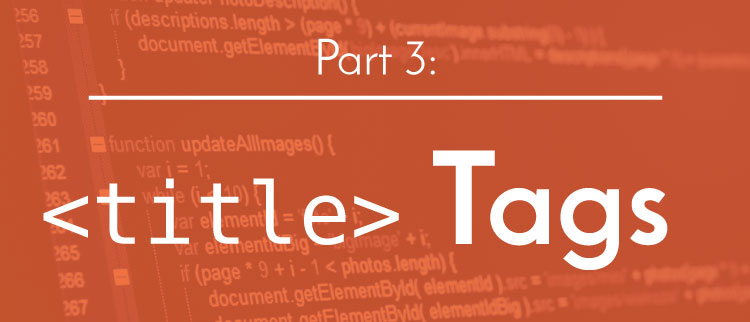Are Title Tags the Most Important Part of Your Website?
Title tags are one of (if not the most) important elements to your site. They’re important for both the search engines and for visitors.
That’s why this is a crucial chapter for you to read and implement for the success of your site.

You’re objective in this chapter is to understand the purpose of title tags and how to properly implement them in your website.
What is a Title Tag?
Title tags are like book titles. While we’re told to “not judge a book by its cover,” the reality is that we do. In the same way that people judge book titles, they judge the titles on your website!
A title tag is a line of code that shows up in four distinct and important locations.
Where do you see title tags?
1. Browser tabs

2. Search engines
(Search engines do have the power to show something different.)

3. Your website

4. Social Media

Importance of title tags
Perhaps most importantly, title tags “sell the click.”
In the code, a title tag appears like this:
<title>Sample Title</title>
This title is the first part of your website visitors, search engines and social media sites see on your website. In a few characters, it will give all three a brief idea of the content of your page and website.
There is no length to the title, but search engines will typically only display 512 pixels or approximately 50-55 characters. Browsers will typically only display 26 characters. This is why it is important to keep the title concise.
It’s important to write title tags that are compelling enough for people to click on from both search engines and social media. (This is also known as “selling the click.”) Title tags also should include the main keyword for which you want to rank in the search engines.
How to Optimize Title Tags For Best Results
We at Orange Fox encourage you to optimize sites for visitors, while at the same time using best practices to achieve high rankings in search engines.
As we previously mentioned, your title is similar to the title of a book in that if it is compelling and engaging, it will receive more attention than a title that is, frankly, boring.
Consider your target audience and what would draw them in to your content.
For example, if you were looking for a plumbing repair service, which one of the titles below would you choose?
Option A) Hiring a Plumber? Here are the 10 Biggest Mistakes
Option B) Plumbing Tips
Option C) Plumber | Plumbing Repair | Plumber Services
Hopefully you picked Option A!
Option B is helpful, but boring. At best, it’s mediocre. Option C is a classic example of someone trying to manipulate search engines. While it informs the visitors about the content of the site, it doesn’t “sell the click” like Option A.
Finally, remember to promote your brand. Sometimes it’s difficult to include your brand name in the title. If possible, add it. Make sure you also put your keyword in your title. The closer the keyword is to the beginning of the title, the better, because it informs searchers immediately that your site is related to the topic they are searching. This also helps you to improve your search engine rankings.
How To Change Your Title Tags
In WordPress, the title of your page or post will be your default title tag. Depending on how your permalinks set up, this will also influence your URL for each page.
We recommend using an SEO plugin for WordPress which gives you a secondary option to adjust your title tags for site variety. For example, site wide, your pages may default to use the title of the post and your brand name which leads to duplicate titles. Avoid this by using the plugin to manually create a title that does not have your brand name at the end.
One of the best parts about the SEO plugins is that you can use it to calculate the length of your title. This way, you can adjust it to the correct length. The field is meant for the meta description, but hey if it works it works!

You’ve met your objective in this chapter of understanding the purpose of title tags and how to properly implement them in your website.